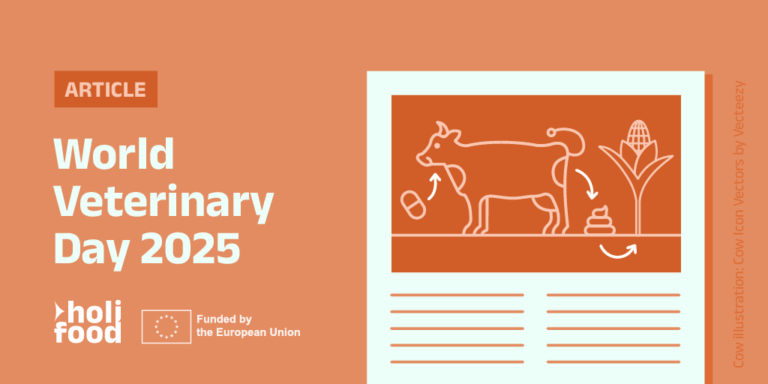Predicting veterinary drug contamination in maize using modeling

World Veterinary Day is celebrated annually on April 26th. This day highlights the essential role veterinarians play in improving animal health and welfare, as well as public health. Veterinarians play a pivotal role in animal farming by administering veterinary drugs to treat animal diseases, not only curing the animals but also avoiding the spread of animal diseases to other animals and human.
The spread of animal diseases to humans is one of the food systems risks’ in a changing global environment that HOLiFOOD project aims to tackle with a holistic approach. In this article, we highlight emerging risks in the work of veterinarians that can potentially affect multiple food systems. Within HOLiFOOD, tools are being developed to help veterinarians and farmers prepare for these emerging hazards. These tools will focus mainly on poultry-, lentil-, and maize supply chains.
Use of veterinary medicine in poultry
Veterinary drugs, especially antibiotics, are crucial in poultry farming to prevent and treat bacterial diseases. However, the use of these drugs must be carefully managed to avoid residues in poultry products as well as development of antimicrobial resistance, which can pose health risks to consumers. Management of using veterinary drugs is becoming increasingly difficult in climate change scenarios. With an increase in temperature and humidity, a rise in heat stress and animal diseases is expected, and with it, a rise in the need for veterinary drugs.
Implications of antibiotic use and a changing environment
Veterinary drug residues can contaminate crops like lentils and maize through manure. Manure from treated animals can introduce drug residues into the soil, which can then be absorbed by plants. This contamination can affect the safety of crops intended for human consumption. The spread of low doses of antibiotics could also promote the occurrence of antibiotic resistant bacteria, posing a risk for human health.
The risk of residues of antibiotics ending up in crops might increase due to climate change. (Flash) floods, as well as heavy precipitation, are expected to occur more often because of climate change. Under influence of heavy rainfall, antibiotics can be spread more readily into surrounding areas, posing a risk if crops are grown near animal farms.
One of the partners within HOLiFOOD, Wageningen Food Safety Research, integrated existing models for parts of the supply chain into a single framework (CirfSafe) to predict antibiotic contamination within a circular food system in, amongst others, maize. Several processes and parameters are considered such as environmental pH and soil carbon content.
Conclusion
Veterinary drugs are essential for maintaining animal health and productivity, their use must be carefully managed to prevent residues in food products. The contamination of crops through manure highlights the interconnected nature of animal and crop farming. Ensuring the safety of our food supply requires a comprehensive approach that includes proper drug use, monitoring, and management practices. The predictive tools developed within the HOLiFOOD consortium may help veterinarians gain insight in upcoming risks to help them work more effectively while maintaining food safety standards in the future.
About the HOLiFOOD porject
What? A 4-year project (2022-2026) funded by the European Commission under the Horizon Europe Programme that aims to introduce an holistic approach for tackling food systems risks in a changing global environment.
About the HOLiFOOD project
How? The project aims to improve the integrated food safety risk analysis (RA) framework in Europe to support the early identification of food safety risks in the food chain for a safe and sustainable food system.



